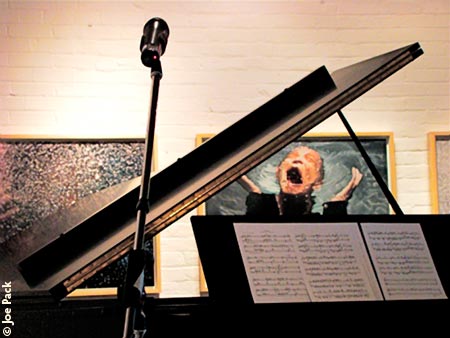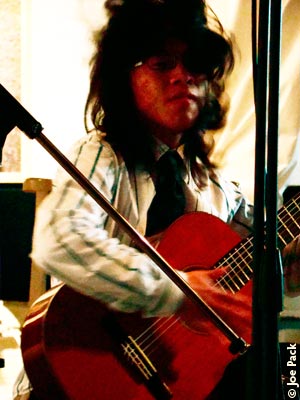 |
| Ping! Creating New Music for Young Musicians |
|
| October 26, 2008 • Gallery 345 • Toronto |
|
|
|
|
|
|
| Report by Jessica Lombardi with photos by Joe Pack |
| The concert was a medium to draw attention to the current research in the educational, compositional, and performance practices of musicians from the contemporary classical music scene, and an opportunity to present new important works alongside reputable models. The Canadian Music Centre’s Norman Burgess Commissioning Fund organized an educating and truly entertaining performance where the audience was inspired to learn from both young learners and successful professionals. |
| The Sunday afternoon performance took place at Gallery 345, an art gallery filled with reflective, multi-layered works, which surrounded the audience and surely influenced the impression of the music presented. The venue was bright with natural light radiating in through large windows, yet the lighting scheme of the gallery focussed all of the artificial light on the art works and left the performers out of the spotlight. |
|
 |
|
| Each of the compositions presented experimented with the foundational elements of music and reflected upon techniques acquired from innovative composers of our Western music tradition. The program began with Linda C. Smith’s piano duet Velvet, followed by the two Norman Burgess commissions, Andrew Staniland’s Night Suite for solo guitar, and Abigail Richardson’s Labyrinth for string orchestra, and concluded with the third string quartet of the renowned Canadian R. Murray Schafer.
Velvet seemed to gradually evolve from silence into an emotionally driven and gently felt out piece, with a subtly-shifting blend of musical textures that created one sound out of the two instruments. In a very skilful manner, Gregory Oh and Eve Egoyan performed the duet with their backs turned towards the audience, showing them their approach to performing the composition and shedding light on how Smith used the instrument to write her music.
|
| The world premiere of Night Suite was preceded by a statement by the composer himself, and the composition in question was described by the composer as ‘risky’ in avant-garde techniques. Written in tablature form — a notation system for reading guitar, and, historically, lute music — this work explored old music traditions and introduced many contemporary techniques. As the composer also explained, this five-movement work required the skill level equal to the Royal Conservatory of Music’s grade 2 repertoire for guitar performance; however, works of this contemporary character is rarely heard of in the Royal Conservatory repertoire, at least until much later in their educational system. The suite was full of refreshing streams of ideas, created by harsh dissonances and unheard of sounds, asymmetrical lines, and interesting physical interactions with the instrument that often required the instrumentalist to utilize unordinary musical gestures. The piece was fairly well performed, but the sensitivity the composition demanded was oftentimes rough and overly-dramatized and the compositional techniques were undermined by the performer Daniel Lee, a student of Staniland, although he was able to charm the crowd with his enthusiasm. |
|

Daniel Lee |
|
| The third work, Labyrinth, was performed by the Schulte Strings — a medium-sized student collective playing under the direction of conductor Michael Schulte — and the composition was again preceded by the composer describing the work and its context. In a variations-type form, her piece made use of contemporary technique, including the addition of vocals, some improvisation and group effects. This string orchestra performed in an intimate manner similar to classical chamber music: each musician was the sole contributor to a unique texture of music.
The St. Lawrence String Quartet’s performance of R. Murray Schafer’s String Quartet No. 3 was interactive and particularly engaging, with all three of its movements varying greatly while remaining unified by the application of avant-garde compositional procedures and extra-musical connections. The first movement began with the cellist performing alone on stage, soon to be joined by the three other performers, but only after a surround-sound exploration with the instruments performing from various areas in the performance space. The second movement had all instrumentalists seated and performing vigorously on their instruments, emphasizing the music with strange vocal additions. In the final movement, the instruments began by performing in monophony — that is, in a singular melody-line — for a while, then slowly developed thicker harmonies and eventually progressed towards a musical separation between the first violinist and the other players. This separation became physically apparent when the violinist stood up and carried his music down the hall and out of the room, with its melody in dialogue with that of the other instrumentalists, then eventually evaporating into thin air but echoing in our memories. Successful as a composer and music educator in the Canadian music field, R. Murray Schafer rightly concluded the concert as his work related to much that was said and heard that afternoon.
|
|
|
|
|
|



